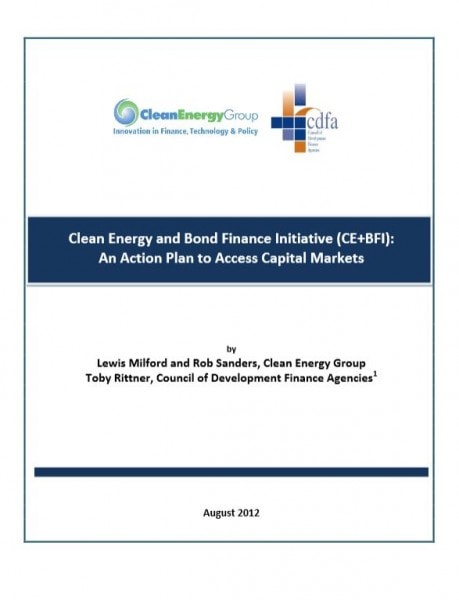September 25, 2012
Bond Financing for Offshore Wind: A Smart Strategy for State Governments
By Anna Brockway

A recent report jointly authored by the Council of Development Finance Agencies and Clean Energy Group makes a case for using bond finance to advance renewable energy development. The report, Clean Energy and Bond Finance Initiative (CE+BFI): An Action Plan to Access Capital Markets, describes an innovative partnership between the two organizations, which will explore clean energy finance options as well as opportunities for public clean energy fund managers and development finance professionals to work together.
Historically, bonds have been used to finance public projects. When a local government wants to build a school, for example, it takes on debt in paying for the project. It can choose to partition that debt into pieces, called bonds, and sell them to the investing public. The government is no longer saddled with debt for a given project, while investors enjoy a steady interest rate and the full repayment of the bond upon its maturation. Municipal bonds are generally safe investments, and diversifying an investment portfolio with government bonds is considered to be a sound practice. And bonds can be used for private projects, too; in this scenario, the government still issues bonds, then loans the proceeds to the borrower, who makes payments to match the bonds’ interest rates. In most cases, especially in these tough economic times, the best bet is to issue bonds for projects that generate revenue to pay off those bonds, so the government does not have to take on any more debt.
But while bonds have helped pay for the construction of roads, bridges, city halls, libraries, hospitals, and other infrastructure and community benefit projects, they have not been used that extensively for clean energy development. As evidenced by the CE+BFI report, the enthusiasm for combining the two is there and growing, especially in light of partisan federal funding stalemates and reduced bank lending in response to the 2008 recession.
On the local level, federal gridlock tends to be a lesser consideration than the tangible benefits of clean energy development that are felt by a multitude of local players. New clean energy projects can stimulate the local private sector, leverage state clean energy funds, and diversify energy resources, lowering long-term energy costs in a given region. In addition, rising property values are appreciated by housing finance authorities. Economic development resulting from technology deployment is an asset to workforce development agencies and universities, which also benefit from the potential for growing innovative, technology-oriented jobs.
All types of clean energy projects are potential candidates for bond financing, but the local impact of offshore wind projects means they are a particularly smart bet for state governments. For one, wind resources are most active at times of peak electricity demand and are located right where they are needed – just off the coasts of heavily populated cities, and particularly off the Atlantic coast of the U.S., where Stanford researchers say offshore wind farms have the potential to generate enough power for one-third of the country’s energy demand. Furthermore, the regulatory landscape has been primed for the development of offshore wind: bipartisan state coalitions and task forces have set goals for offshore wind energy generation, identified appropriate sites, performed environmental impact studies, and made strides in the permitting process.
And, perhaps most importantly from an economics perspective, larger credit-worthy purchasers of offshore wind power such as state and federal governments can use their utility payments to pay off the debt service for those bonds. If revenue bonds are used to finance clean energy projects, then the government itself need not take on more debt.
Moreover, offshore wind projects will generate large amounts of clean energy and therefore magnify the associated benefits. The considerable size of offshore wind turbines means it is most economical to manufacture their components close to their final deployment site, so job creation and energy benefits from the offshore wind industry accrue to a specific region. For a state or local government seeking projects that will benefit the local economy, that’s a smart investment for bond financing.














